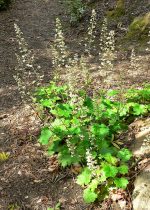 Also called Channel Islands coral bells, and Jill of the rocks, this evergreen herbaceous perennial is a member of the saxifrage family, Saxifragaceae, that also includes astilbe, tiarella, and bergenia. It is endemic to the four northern Channel Islands of California where it grows on canyon cliffs in coastal sage scrub areas. Plants grow 1.5-3′ tall from a rhizomatous root system, form a 2′ wide mound of dark green leaves that are marbled and may have a reddish tinge in winter. Each leaf is 3-5″ long, rounded, deeply 7-9 lobed with a fringe of hairs on the edge, and is carried on a long petiole. From late winter into spring 3′ long branched spikes of small pinkish flowers appear well above the foliage. Each flower is hairy and glandular and has prominent stamens with large anthers. The genus name, Heuchera, honors Johann Heinrich von Heucher (1677-1747) a botanist, physician, and medicinal plant expert at Wittenberg University, Germany. The specific epithet, maxima, is the Latin word meaning largest.
Also called Channel Islands coral bells, and Jill of the rocks, this evergreen herbaceous perennial is a member of the saxifrage family, Saxifragaceae, that also includes astilbe, tiarella, and bergenia. It is endemic to the four northern Channel Islands of California where it grows on canyon cliffs in coastal sage scrub areas. Plants grow 1.5-3′ tall from a rhizomatous root system, form a 2′ wide mound of dark green leaves that are marbled and may have a reddish tinge in winter. Each leaf is 3-5″ long, rounded, deeply 7-9 lobed with a fringe of hairs on the edge, and is carried on a long petiole. From late winter into spring 3′ long branched spikes of small pinkish flowers appear well above the foliage. Each flower is hairy and glandular and has prominent stamens with large anthers. The genus name, Heuchera, honors Johann Heinrich von Heucher (1677-1747) a botanist, physician, and medicinal plant expert at Wittenberg University, Germany. The specific epithet, maxima, is the Latin word meaning largest.
Type: Evergreen herbaceous perennial
Bloom: Three foot long branched spikes of small pinkish flowers from late winter into spring
Size: 1.5-3′ H x 1-2′ W
Light:Partial shade
Soil: Average, medium moist to dry, well-drained; drought tolerant
Hardiness: Zones 9-10
Care: Deadhead to prolong bloom; divide every 3-4 years to retain vigor
Pests and Diseases: None of significance
Propagation: Seed, division in fall
Companion Plants:Monkey flowers, California lilac, Coreopsis
Outstanding Selections:’Santa Ana Cardinal’ (hybrid with H. sanguinea; floriferous, free-flowering, long bloom time; rose red flowers)
Photo Credit: Stan Shebs Wikimedia Commons